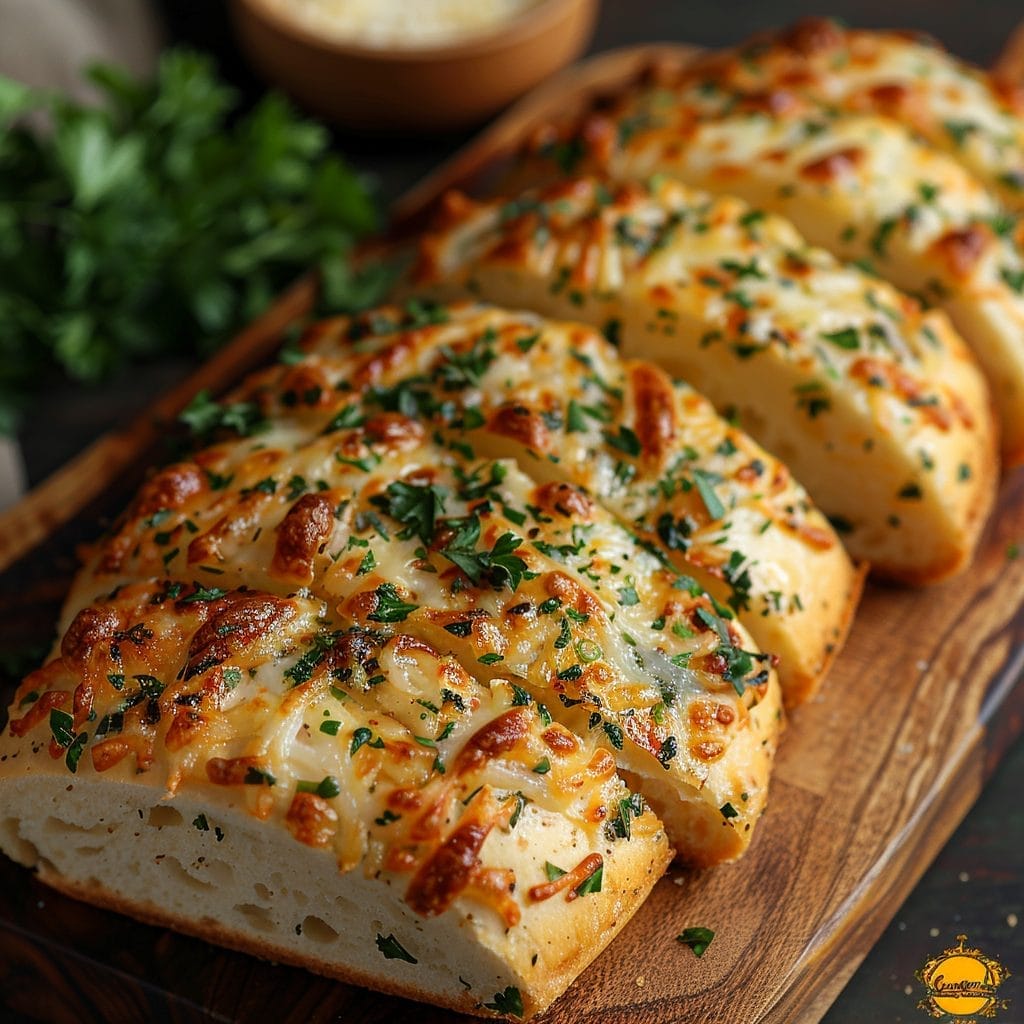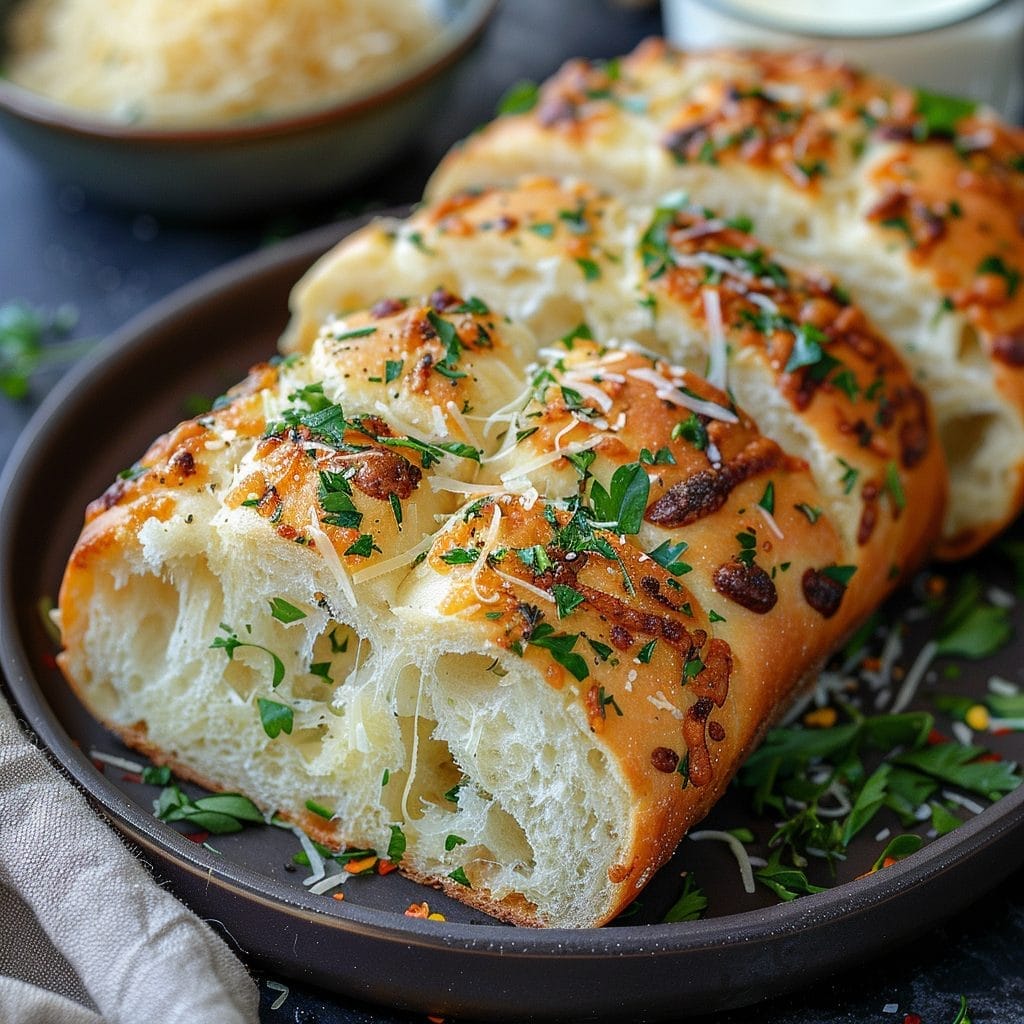Jump to Recipe
My earliest memory of authentic Italian bread comes from my nonna’s cozy kitchen in Naples. Every Sunday, the aroma of freshly baked Italian herbs and cheese bread filled the air, carrying scents of aromatic herbs and melted cheese that could make anyone’s mouth water. As Nonna kneaded the dough, she’d tell tales of how her mother, and her mother before that, had perfected this homemade bread recipe.
Growing up, I couldn’t resist sneaking bits of dough when she wasn’t looking, marveling at the magical transformation that turned flour, water, and a handful of herbs into a gourmet baking masterpiece. Now, I’m thrilled to share our family’s secret recipe and tips with you. Get ready to embark on an Italian culinary journey that promises to enrich your baking repertoire.
The Perfect Blend of Italian Herbs
Creating the ultimate Italian herbs and cheese bread starts with selecting the right herbs. The ideal blend creates a flavor that’s both complex and harmonious, providing a perfect symphony for your taste buds. Let’s dive into the essentials of choosing and using these aromatic ingredients.
Choosing the Right Herbs
The quintessential Italian seasoning includes herbs like basil, oregano, thyme, and rosemary. Each herb brings its own unique flair, from oregano’s robust earthiness to basil’s sweet freshness. When crafting your perfect herb blend, consider balancing strong flavors with more delicate ones to achieve a well-rounded taste.
Fresh vs. Dried Herbs
When it comes to fresh herbs versus dried herbs, both have their merits. Fresh herbs offer vibrant flavors and can elevate your bread to new heights. Dried herbs, on the other hand, are more concentrated and require less quantity. I often use dried herbs for a deeper, more intense flavor, but don’t steer away from fresh herbs for their lively notes.
Storing and Using Italian Herbs
Proper storage is key to maintaining the potency and aroma of your Italian seasoning. For fresh herbs, store them in the fridge, wrapped in damp paper towels, or in a glass of water to keep them perky. When it comes to dried herbs, keep them in airtight containers in a cool, dark place. These herb storage tips ensure that the flavors remain as bold and aromatic as the day you bought them.
Best Cheese Types for Italian Bread
Cheese isn’t just an ingredient; it’s the heart of flavor for any Italian herbs and cheese bread. Selecting the right cheeses enhances the overall taste and texture of the bread, making each bite unforgettable.
Popular Cheese Choices
The most popular Italian cheeses for bread are mozzarella and parmesan. These cheeses bring unique qualities to the bread, making them exceptional choices.
- Mozzarella is known for its melting properties and mild, creamy flavor.
- Parmesan: Offers a robust, nutty taste with a granular texture.
Flavor Profiles and Characteristics
Let’s dive into the flavor profiles and characteristics of these cheeses that make them ideal for baking.
Mozzarella: Mozzarella boasts a delicate, milky flavor and a smooth texture. It melts beautifully, creating a deliciously gooey and stretchy consistency that’s perfect for bread.
Parmesan: Parmesan, on the other hand, provides rich flavors with its sharp, savory notes. Its crumbly texture and impactful taste contrast the softness of the bread, adding depth to every bite.
Combining mozzarella and parmesan in your Italian bread creates a harmonious blend of rich flavors and diverse textures, ensuring a delightful experience for your taste buds.
Step-by-Step bread-making process
Making homemade Italian herbs and cheese bread is an enriching experience. Let’s dive into the detailed steps for a truly delightful outcome.
Gather Essential Ingredients
Start with the freshest ingredients for the best homemade bread preparation. You’ll need high-quality flour, yeast, water, salt, your favorite Italian herbs, and cheese. Remember, fresh herbs elevate the flavors immensely.
Mixing and Kneading Techniques
Combine the dry ingredients first, then gradually add water. Mix until a sticky dough forms, and proceed to knead the dough on a floured surface. Knead until smooth and elastic; this helps to develop gluten, which is crucial for structure.
Proofing and Rising Tips
Proofreading is the key to fluffy bread. Place the kneaded dough in a greased bowl, cover, and let it rise until doubled in size. Great bread-proofing occurs in a warm, draft-free environment. Punch the dough down gently before shaping it for the final rise.

Baking Tips for a Perfect Crust
The secret to achieving a crispy crust starts with the right temperature. Preheat your oven to 450°F to get that golden brown bread. This high heat caramelizes the sugars in the dough, giving you that beautiful crispiness.
Investing in a baking stone can make a huge difference. The stone retains heat and distributes it evenly, making sure your bread cooks consistently. Place it in the oven as it preheats to optimize its effect.
To add moisture, which is one of the real oven baking secrets, place a shallow pan of water at the bottom of the oven. The steam produced helps develop a crispy exterior while preserving a soft, fragrant interior.
Finally, don’t overlook timing. Bake your bread for about 25–30 minutes. Keep an eye on the color; it should be golden brown when done. If you’re unsure, an instant-read thermometer can confirm it—aim for an internal temperature of 200–210 °F.
By manipulating these elements, you’ll master the oven-baking secrets that transform ordinary dough into a masterpiece. Enjoy every bite of your crispy crust and savor the golden brown bread you’ve baked to perfection.
Common Mistakes to Avoid
Even seasoned bakers fall into several traps when making Italian herbs and cheese bread. Here are some common baking pitfalls to look out for, which I’ve discovered through countless baking sessions.
Over/Under Proofing
Dough proofing is crucial. Over-proofed dough becomes too airy, while under-proofed dough is dense and heavy. Keep a close eye on your dough to achieve a perfect rise.
Incorrect Oven Temperature
Oven settings can make or break your bread. Too hot, and the crust burns before the inside cooks through. Too cool, and your bread might end up pale and gummy inside. Always preheat your oven and use an oven thermometer to ensure accuracy.
Inadequate Kneading
A well-kneaded dough results in a uniform crumb and optimal texture. Skimping on kneading can lead to poor gluten development, resulting in a flat and dense loaf. Dedicate enough time to knead your dough properly.
Pairing Italian Herbs and Cheese Bread with Meals
There’s something truly magical about the aroma of freshly baked Italian herbs and cheese bread, especially when paired with your favorite meals. This versatile bread is a star in a variety of bread pairings, enhancing any spread with its rich flavors. Let’s dive into delightful ways to integrate this bread into your Italian cuisine experiences.
Served With Pasta Dishes
One of my favorite bread pairings is serving this delectable bread with classic pasta dishes. Picture a plate of spaghetti topped with marinara sauce, complemented by a slice of warm, fragrant Italian herbs and cheese bread. The combination is unbeatable and elevates a simple meal to an extraordinary dining experience. Try dipping your bread in the pasta sauce for an extra burst of flavor.
Great for Sandwiches
This bread is also perfect for constructing mouthwatering sandwiches. Imagine a hearty panini with layers of fresh mozzarella, tomatoes, and basil, nestled between slices of our Italian herbs and cheese bread. It’s a fantastic way to bring a touch of Italian cuisine to your lunch. The unique flavor profile of the bread enhances every bite, making it irresistible.
Delicious as a Snack
You don’t need an elaborate meal to enjoy this bread. Sometimes, a simple slice with a bit of olive oil or a sprinkling of sea salt can be the perfect snack. You can get creative with versatile bread recipes by adding toppings like hummus, avocado, or even Nutella for a sweet twist. It’s a quick and delicious way to satisfy your cravings.
Exploring these bread pairings reveals the true versatility of Italian herb and cheese bread, making it a must-have for every meal. Enjoy crafting these versatile bread recipes and bringing a touch of Italian charm to your table.

Italian Herbs and Cheese Bread
Ingredients
Method
- Step-by-Step Guide:
- Prepare the Dough:
- In a large mixing bowl, combine the warm water, sugar, and yeast. Let it sit for about 5 minutes until it becomes frothy.
- Add the flour, salt, dried herbs, mozzarella, and Parmesan cheese to the yeast mixture. Mix until a sticky dough forms.
- Knead the Dough:
- Transfer the dough to a floured surface and knead it for about 8-10 minutes, until it is smooth and elastic. Add a little more flour if the dough is too sticky.
- Proof the Dough:
- Place the kneaded dough in a greased bowl. Cover it with a clean kitchen towel and let it rise in a warm place for about 1-2 hours, or until it doubles in size.
- Shape the Bread:
- Punch down the risen dough to release air. Shape it into a loaf or place it in a greased bread pan. Cover it again and let it rise for another 30 minutes.
- Preheat the Oven:
- Preheat your oven to 450°F (230°C). Place a shallow pan of water at the bottom of the oven to create steam.
- Bake the Bread:
- Bake the bread for 25-30 minutes or until it turns golden brown and sounds hollow when tapped. The internal temperature should reach 200-210°F.
- Cool and Serve:
- Let the bread cool on a wire rack before slicing. Enjoy it warm or at room temperature!
Notes
This bread pairs beautifully with pasta, sandwiches, or can be enjoyed with olive oil as a simple snack.
Conclusion
What a journey it has been! We’ve delved into the secrets behind crafting savory Italian herbs and cheese bread, embracing authentic Italian flavors and techniques. From mastering the perfect blend of herbs to selecting cheeses that enhance every bite, these insights form the foundation of your new bread-making prowess.
Your newfound knowledge of choosing the right ingredients, understanding the intricacies of kneading, and avoiding common mishaps will surely make you a master bread baker. Remember, the joy of this process lies not just in the end product but in each step of the way. The aroma of freshly baked bread and the satisfaction of that first crunchy bite are second to none!
Now, let this culinary adventure inspire your future creations. Whether you’re serving it with a classic pasta dish, building the ultimate sandwich, or enjoying it as a snack, your homemade Italian herbs and cheese bread will bring warmth and delight to any meal. Keep the spirit of Italian cooking inspiration alive in your kitchen, and let every loaf remind you of the beautiful tradition you’ve embraced.

